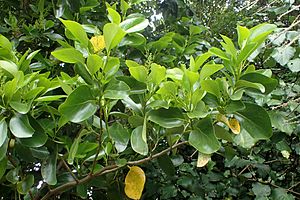Heterocrossa gonosemana facts for kids
Quick facts for kids Heterocrossa gonosemana |
|
|---|---|
| Scientific classification | |
| Kingdom: | |
| Phylum: | |
| Class: | |
| Order: | |
| Family: |
Carposinidae
|
| Genus: | |
| Species: |
H. gonosemana
|
| Binomial name | |
| Heterocrossa gonosemana Meyrick, 1882
|
|
| Synonyms | |
|
|
The Heterocrossa gonosemana is a type of moth. It belongs to the Carposinidae family. This moth is special because it is endemic to New Zealand. This means it can only be found there.
Contents
The Heterocrossa gonosemana Moth
What's in a Name?
A scientist named Edward Meyrick first described this moth in 1882. He found it in Dunedin, New Zealand. Over the years, scientists have discussed which group, or "genus," this moth belongs to.
For a while, it was thought to be in the Carposina genus. But later, in 1978, another scientist named Elwood Zimmerman said that moths in the Heterocrossa group have special body parts that make them different. So, in 1988, the moth was put back into the Heterocrossa genus. The main example specimen of this moth is kept at the Natural History Museum, London.
What Does It Look Like?
This moth is about 9 millimeters long. Its head is white, and its feelers (palpi) are mostly dark brown and white. The antennae are white with some dark rings. The body is mostly white and yellowish.
Its front wings are long and narrow. They are mostly white with some grey spots. There are also black lines and dots, especially near the front edge. Some parts have raised scales that look like small bumps. The back wings are a greyish-white color. Moths found in the southern parts of New Zealand often look darker than those in the north.
Where Does It Live?
This moth lives only in New Zealand. You can find it all over the country. It has been seen in places like Wellington, Nelson, Dunedin, and even on Stewart Island and Auckland Island.
Life Cycle and Habits
You can usually see the adult moths flying from November to February. During the day, they often rest on tree trunks. Their colors help them blend in with the tree bark and lichen. This makes it hard for predators to spot them.
When the young moths, called larvae, are disturbed, they move very quickly. This moth spends the winter as a pupa. A pupa is like a resting stage before it turns into an adult moth. The pupa is about 8 millimeters long and is greenish-white. It has large cases for its legs and wings.
The pupa lives inside a cocoon. The cocoon is oval-shaped and about 12 millimeters long. It is usually found in the soil under the plant the larva ate. When scientists raised these moths, the adult moths came out of their cocoons in December. Adult moths are often attracted to lights at night.
Home and Food
This moth likes to live in forest areas. The larvae of this moth eat the seeds and fruit of a plant called Griselinia lucida. They might also eat the fruit of another similar plant, Griselinia littoralis.


